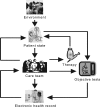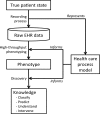Next-generation phenotyping of electronic health records
- PMID: 22955496
- PMCID: PMC3555337
- DOI: 10.1136/amiajnl-2012-001145
Next-generation phenotyping of electronic health records
Abstract
The national adoption of electronic health records (EHR) promises to make an unprecedented amount of data available for clinical research, but the data are complex, inaccurate, and frequently missing, and the record reflects complex processes aside from the patient's physiological state. We believe that the path forward requires studying the EHR as an object of interest in itself, and that new models, learning from data, and collaboration will lead to efficient use of the valuable information currently locked in health records.
Figures


References
-
- Blumenthal D, Tavenner M. The “meaningful use” regulation for electronic health records. N Engl J Med 2010;363:501–4 - PubMed
-
- Heitjan DF, Basu S. Distinguishing “missing at random” and “missing completely at random”. Am Statistician 1996;50:207–13
Publication types
MeSH terms
Grants and funding
LinkOut - more resources
Full Text Sources
Other Literature Sources
Medical

